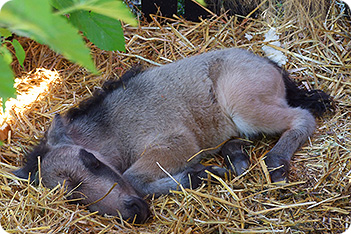
Horse Stable Types
Foaling Box

Foaling Box
A Foaling box is a stable specially designed for a mare and a foal. A foaling box has different specifications to a normal stable and care taken at the design stage will allow you to have a well run and manageable unit that will support your mare before and after she foals.
Design Specifications
- Stable Size
The size of a foaling box needs to be considerably larger than a normal stable due to the added space required by the mare during and after foaling has taken place. If the stable is too small then the mare is likely to get cast when she is rolling and getting up and down and there will also be the added risk of the foal becoming trapped or squoshed by the mare during and also after foaling. Mare and foal boxes should be at least 12 feet by 12 feet to 14 feet by 14 feet depending on the size of the horse. - Stable Door Size
The width of the door must be wide enough to accommodate your mares increased size towards the end of her pregnancy. - Field Access
The Field should be as close as possible to the stable so that the young foal does not have too far to walk in the early days.
The walkway to the field should ideally be on a flat non slip surface that is not too stony for young hooves. And the walkway itself should be a safe environment to walk along.
Your mare in foal should be in a field with quiet horses, so that she is not stressed or bullied and depending on your mare, when she has foaled she should go out either on her own with her new foal or with a quiet group of other mare and foals, or a quiet group of mares, care not to stress either mare or foal out must be a primary concern. - Stable Access
Access into the foaling box is also important, there must be sufficient room to easily lead your horse into and out of the stable. - Veterinary Access
Have your foaling box positioned as close to the veterinary room as possible, will allow for ease of treatments.
Ensure that there is sufficient room close enough for your veterinary to park. - Water Supply
Water must be available to the mare at all times and it needs to be kept up off the ground so that the new born foal cannot fall into them or drown. The use of water mangers, water drinkers or brackets that hold water buckets are all sensible choices. Whatever your choice ensure that the water supply is checked and cleaned out on a regular basis. - Feed Mangers
Feed mangers made of rubber are ideal for your mare early on to prevent there from being any bulky hard buckets on the floor, that your foal could fall into or over. By using a manger that has two partitions one with slightly smaller bars across for the foal, will allow you to feed your mare and foal different feeds and have the knowledge that your mare will be unable to fit her nose through the smaller bars of the foals side of the feed manger to eat the feed.
Foaling Box Design Specifications Continued...
- Hay Rack
The use of hay nets is not advised for a mare and foal stable due to the risk of mare or foal becoming entangled in it. Hay put on the floor is easily trampled into the bed, so a hay rack is an ideal solution as they can be positioned either in a corner or along the side of the wall and they will therefore be high enough off the ground and secure enough not to cause any safety issues. - Wall Panelling
For a foaling box the wall must be smooth and offer protection against becoming cast. This is especially important during foaling when the mare will be become very restless. Rubber matting with anti cast ridges will help to allow your mare to push away from the wall in such a case.
The addition of high and deep straw banks along with a deep bed are also measures that will help to prevent this from happening and will also provide protection for the foal from being stuck in a corner or trapped against the wall. - Lighting
The foaling stable needs to be well lit so that any veterinary treatment can be undertaken with ease. By having some soft lighting in the stable will allow you to monitor your mare in the night prior to and after foaling without necessarily disturbing her. - Surveillance
Using closed circuit television is a great way of being able to monitor your mare before foaling and keep an eye on them after too, as it allows you monitor at a safe distance without disturbing your mare.
Other options are the use of a side panel in the stable wall, which can be slid back when you wish to have look and then shut afterwards, take care with these panels not to disturb your mare. - Ventilation
Like with any stable there must be adequate ventilation without draughtiness. - Floor
The floor should be well draining to allow for ease of cleaning and disinfecting. - Heating
The use of special equestrian heat lamps within the stable will allow you safely warm up the stable and help a sick mare or foal to recover.